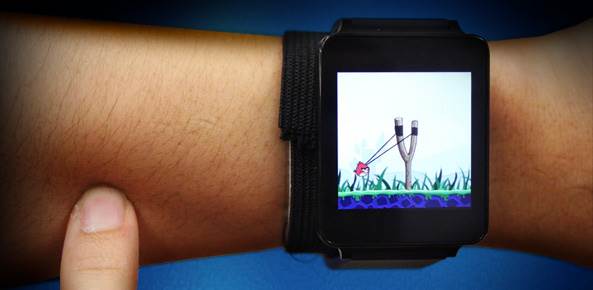A wearable technology developed by researchers at Carnegie Mellon University may one day make touchscreens for smart watches unnecessary as users could issue commands to their devices simply by touching their own arms. The new technology would essentially transform a user’s entire lower arm into a touchpad, capable of receiving commands traced on the skin.
The system, called SkinTrack, was developed by Carnegie Mellon’s Human-Computer Interaction Institute’s Future Interfaces Group (HCII). The interface supports continuous touch tracking on both the hands and arms. It can detect contact at different locations on the skin, making it possible to emulate the same sort of user interactions involved in clicking on buttons or swiping sliders on a virtual keyboard.
A Touchscreen in a Ring
SkinTrack isn’t the first attempt by researchers to develop such a wearable computer interface. But other designs focused on users wearing either some sort of flexible input device, an interactive textile of some type, or a projector and camera combination.
In contrast, the SkinTrack interface uses only a special ring worn on a finger. The ring generates a low-energy, high-frequency signal that is conducted through the skin when the finger nears or makes contact, researchers at Carnegie Mellon reported. The technology can even work over clothing.
“The great thing about SkinTrack is that it’s not obtrusive; watches and rings are items that people already wear every day,” said Yang Zhang, a first-year Ph.D. student in HCII. He will present details of the technology May 10 at the Association for Computing Machinery’s Conference on Human Factors in Computing in San Jose, Calif.
SkinTrack uses electrodes integrated into the strap of a smart watch, according to the research team. The source of the electromagnetic waves coming from the ring can be pinpointed because the phase of the waves will vary. Electrodes corresponding to the 12 o’clock and 6 o’clock positions on the watch, for instance, can detect phase differences that can determine the position of the finger along the width of the arm; electrodes at the 3 o’clock and 9 o’clock positions can determine the finger’s position along the length of the arm.
Touchscreen Accuracy
The research team found they could determine when the finger was touching the skin with 99 percent accuracy and could resolve the location of the contact with a mean error of 7.6 millimeters. That compares well with other on-body finger-tracking systems and approaches touchscreen-level accuracy.
The researchers showed that the system could have a number of different use cases for smart watches, including as a game controller, scrolling through lists, zooming in and out of maps, and to draw. A number pad application, meanwhile, enabled researchers to use the back of the hand as a dial pad for the onscreen number pad.
The concept is not quite foolproof yet. In addition to the challenges of battery life inherent in such a small device, the body’s own electrical signals can change due to factors such as sweat and hydration.
Homer:
Posted: 2016-05-06 @ 12:29pm PT
Enjoy your wearable. See you in the cancer treatment center.







